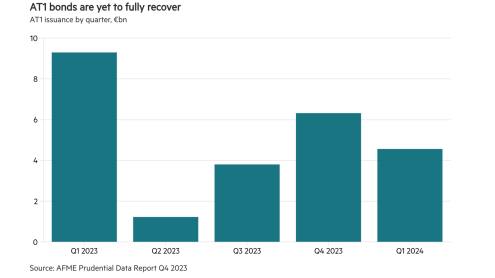The economies of all five of the Nordic countries expanded in 2021, after a year of contraction as a result of the coronavirus pandemic. Sweden saw the biggest growth in its gross domestic product in 2021 at 4%, with Denmark (3.8%), Finland (3%), Iceland (3.7%) and Norway (3%) also reporting robust growth last year, according to data from Statista. The region’s return to solid growth is also reflected in the performance of its lenders with almost all banks reporting an increase in their pre-tax profits in The Banker’s 2022 Top 30 Nordic Banks ranking.
In the overall ranking by Tier 1 capital, which is based on end-2021 results, Finland’s Nordea Group remains way out in front with a Tier 1 capital position of $32.97bn. Meanwhile, Denmark’s Danske Bank and Norway’s DNB Group have maintained their second and third spots, with Tier 1 capital positions of $26.2bn and $23.18bn, respectively.
The only changes to the top 10 list are Finland’s OP Pohjola Group and Denmark’s Nykredit switching places, with the former moving up from eighth to seventh. In addition, Norway’s Sparebank 1 SR Bank’s enters the top 10, pushing Santander Consumer Bank Nordic out of the elite group. Another significant move sees Klarna Bank leap from 27th to 15th, in a sign of the continued impressive growth of the Swedish neobank.
However, unlike in 2020 when most Nordic lenders were able to bolster their Tier 1 capital positions, 2021 saw a decline in Tier 1 capital for most banks in the region. Out of the top 30 Nordic banks, 16 reported a drop in their Tier 1 positions, albeit small drops for the most part. Sweden’s Lansforsakringar Bank saw the biggest decline in percentage terms, with a 20.8% drop year-on-year. Meanwhile, Sweden’s Nordax Bank saw the biggest increase in its position with a rise of 204.3%. The same number of banks (16) also saw a decline in their assets, with Danske Bank reporting the biggest decrease in percentage terms at -11.52%.
There has been a major reshuffle at the top of The Banker’s 2022 overall best-performing Nordic banks table. Iceland’s Landsbankinn has shot up to first place with an overall score of 6.81, followed closely by Denmark’s Arbejdernes Landsbank with a score of 6.8. Iceland’s Islandsbanki has taken third spot with a score of 6.75, while Norwegian savings banks, Sparebank 1 Nord Norge and Sparebank 1 Sorost-Norge, round off the fourth and fifth places, respectively. Landsbankinn did not even make the overall top 10 list last year, while Denmark’s Saxo Bank, last year’s best-performing Nordic bank, did not make the overall top 10 this year.
Landsbankinn’s rise to the top of the best-performing ranking can be attributed to its strong performance in terms of its profitability, asset quality, return on risk and soundness, where the bank is ranked in the top three among its Nordic peers. However, what brings Landsbankinn down is its liquidity metric, where it is ranked 21st with a score of 4.32.
In the top 10 banks by growth, Sparebank 1 Sorost Norge has taken first place with an impressive score of 9.39, followed by Nordax Bank with a score of 9.13 and Arbejdernes Landsbank with a score of 8.84. Klarna Bank, which surged to first spot last year with a score of 10, sits in fourth place this year with a score of 8.14. Iceland’s Arion Bank rounds off the top five with a score of 4.82.
Icelandic banks have taken a clean sweep of the top three positions in the profitability and return-on-risk tables, led by Arion Bank, Islandsbanki and Landsbankinn.
Arion Bank tops the profitability table with a score of 8.24, followed by Islandsbanki with a score of 7.92 and Landsbankinn with a score of 7.81. Denmark’s Ringkjobing Landbobank and Arbejdernes Landsbank take fourth and fifth spot, with scores of 7.46 and 7.44, respectively. Three Norwegian banks and a bank each from Denmark and Sweden round off the top 10 banks by profitability.
The top three positions in the return-on-risk table mirrors the top three of the profitability table, with Arion Bank taking top spot with a score of 8.52, followed by Islandsbanki with a score of 8.17 and Landsbankinn with a score of 7.83. Sweden’s SEB and Swedbank take fourth and fifth spots with scores of 7.66 and 7.55, respectively. Three Norwegian banks and a bank each from Denmark and Finland round off the top 10.
It is a complete change at the top of the asset quality table with neither of last year’s top two – Sweden’s Svenska Handelsbanken and Denmark's Saxo Bank – making it into this year’s top 10. Landsbankinn has taken first spot this year with a score of 8.62, followed by Arion Bank with a score of 8.53 and Sweden’s Lansforsakringar Bank keeping its third spot from last year with a score of 8.51.
Klarna Bank tops the soundness and leverage tables with a score of 9.64 and a perfect 10, respectively. Landsbankinn and Islansbanki round off the second and third spots, respectively, for the soundness ranking, while Nordax bank and Santander Consumer Bank Nordic take the second and third places, respectively, for leverage.
The Banker’s Top 30 Nordic Banks ranking shows a banking sector that has remained strong during the pandemic with solid profitability, asset quality and capital. The region’s lenders are well positioned to continue to see strong growth as the economic recovery gathers pace. The situation in Russia will present macroeconomic challenges but in terms of direct exposure to the region, Nordic banks are well shielded with current exposures to Russia representing less than 1% of their total assets.












